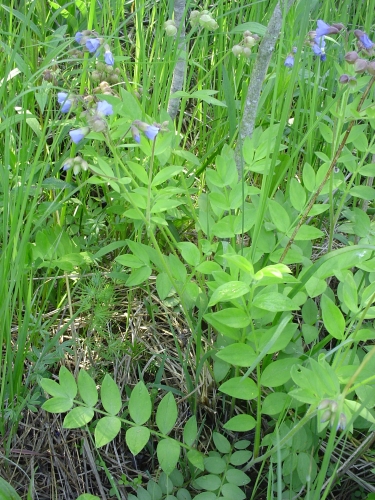Plants and Animals
Polemonium reptans Jacob's ladder
Key Characteristics
Small forb of wet forests, prairies, and fens; leaves pinnately compound with small, elliptical leaflets (2-4 cm long); blue, bell-shaped flowers borne in loose clusters.
Status and Rank
US Status: No Status/Not Listed
State Status: T - Threatened (legally protected)
Global Rank: G5 - Secure
State Rank: S2 - Imperiled
Occurrences
| County | Number of Occurrences | Year Last Observed |
|---|---|---|
| Berrien | 20 | 2013 |
| Cass | 10 | 2008 |
| Lapeer | 1 | 1968 |
| Lenawee | 1 | 1999 |
| Oakland | 1 | 2005 |
| Van Buren | 1 | 2005 |
| Washtenaw | 1 | 1982 |
Information is summarized from MNFI's database of rare species and community occurrences. Data may not reflect true distribution since much of the state has not been thoroughly surveyed.
Habitat
This species frequently inhabits prairie fens, wet prairies, and mesic floodplains.
Natural Community Types
- Floodplain forest
- Mesic prairie
- Mesic southern forest
- Prairie fen
- Rich tamarack swamp
- Southern hardwood swamp
- Southern shrub-carr
- Southern wet meadow
- Wet prairie
- Wet-mesic prairie
For each species, lists of natural communities were derived from review of the nearly 6,500 element occurrences in the MNFI database, in addition to herbarium label data for some taxa. In most cases, at least one specimen record exists for each listed natural community. For certain taxa, especially poorly collected or extirpated species of prairie and savanna habitats, natural community lists were derived from inferences from collection sites and habitat preferences in immediately adjacent states (particularly Indiana and Illinois). Natural communities are not listed for those species documented only from altered or ruderal habitats in Michigan, especially for taxa that occur in a variety of habitats outside of the state.
Natural communities are not listed in order of frequency of occurrence, but are rather derived from the full set of natural communities, organized by Ecological Group. In many cases, the general habitat descriptions should provide greater clarity and direction to the surveyor. In future versions of the Rare Species Explorer, we hope to incorporate natural community fidelity ranks for each taxon.
Associated Plants
Tamarack, grass-of-parnassus, shrubby cinquefoil, Virginia mountain mint, Ohio goldenrod, Riddell's goldenrod, Indian grass, hardstem bulrush, three-square, twig-rush, prairie dropseed, small white lady's slipper, bog valerian, edible valerian, rush, golden-seeded spike-rush, spike-rush, joe-pye weed, pitcher-plant, sun dew, Sphagnum mosses, common boneset, little bluestem, big bluestem, blue-joint grass, whorled loosestrife, black-eyed Susan, marsh fern, bog birch, dogwoods, willows, alder-leaved buckthorn, meadowsweet, water hemlock, bog clearweed, strict sedge, and marsh bellflower.
Management Recommendations
Since Jacob's ladder occurs in both open and shaded situations, it is probably less vulnerable to shading by woody species than many other fen and prairie plants. It is undoubtedly sensitive to hydrologic alterations.
Survey Methods
Random meander search covers areas that appear likely to have rare taxa, based on habitat and the judgment of the investigator.
-
Meander search
-
Survey Period: From first week of May to first week of June
-
References
Survey References
- Elzinga, C.L., D.W. Salzer, and J.W. Willoughby. 1998. Measuring and Monitoring Plant Populations. The Nature Conservancy and Bureau of Land Management, Denver. BLM Technical Reference 1730-1. 477pp.
- Goff, G.F., G.A. Dawson, and J.J. Rochow. 1982. Site examination for Threatened and Endangered plant species. Environmental Management 6(4): 307-316
- Nelson, J.R. 1984. Rare Plant Field Survey Guidelines. In: J.P. Smith and R. York. Inventory of rare and endangered vascular plants of California. 3rd Ed. California Native Plant Society, Berkeley. 174pp.
- Nelson, J.R. 1986. Rare Plant Surveys: Techniques For Impact Assessment. Natural Areas Journal 5(3):18-30.
- Nelson, J.R. 1987. Rare Plant Surveys: Techniques for Impact Assessment. In: Conservation and management of rare and endangered plants. Ed. T.S. Elias. California Native Plant Society, Sacramento. 8pp.
Technical References
- Cooperrider, T.S. 1995. The Dicotyledonae of Ohio Part 2. Linaceae through Campanulaceae. Ohio State University Press, Columbus. 656pp.
- Gleason, H. A., and A. Cronquist. 1991. Manual of Vascular Plants of Northeastern United States and Adjacent Canada. Second edition. The New York Botanical Garden, Bronx. 910pp.
- Gray, A. 1950. Gray's Manual of Botany; eighth ed. Van Nostrand Reinghold, New York. 1632pp.
- Holmgren, N.H. 1998. Illustrated Companion to Gleason and Cronquist's Manual. Illustrations of the vascular plants of Northeastern United States and adjacent Canada. New York Botanical Garden, Bronx. 937pp.
- Mohlenbrock, R.H. 1986. Guide to the Vascular Flora of Illinois. Southern Illinois University Press, Carbondale. 507pp.
- Swink, F. and G. Wilhelm. 1994. Plants of the Chicago Region, 4th ed. Indiana Academy of Science, Indianapolis. 921pp.
- Voss, E.G. 1996. Michigan Flora. Part III. Dicots (Pyrolaceae-Compositae). Bulletin of the Cranbrook Institute of Science and University of Michigan Herbarium. 622pp.



